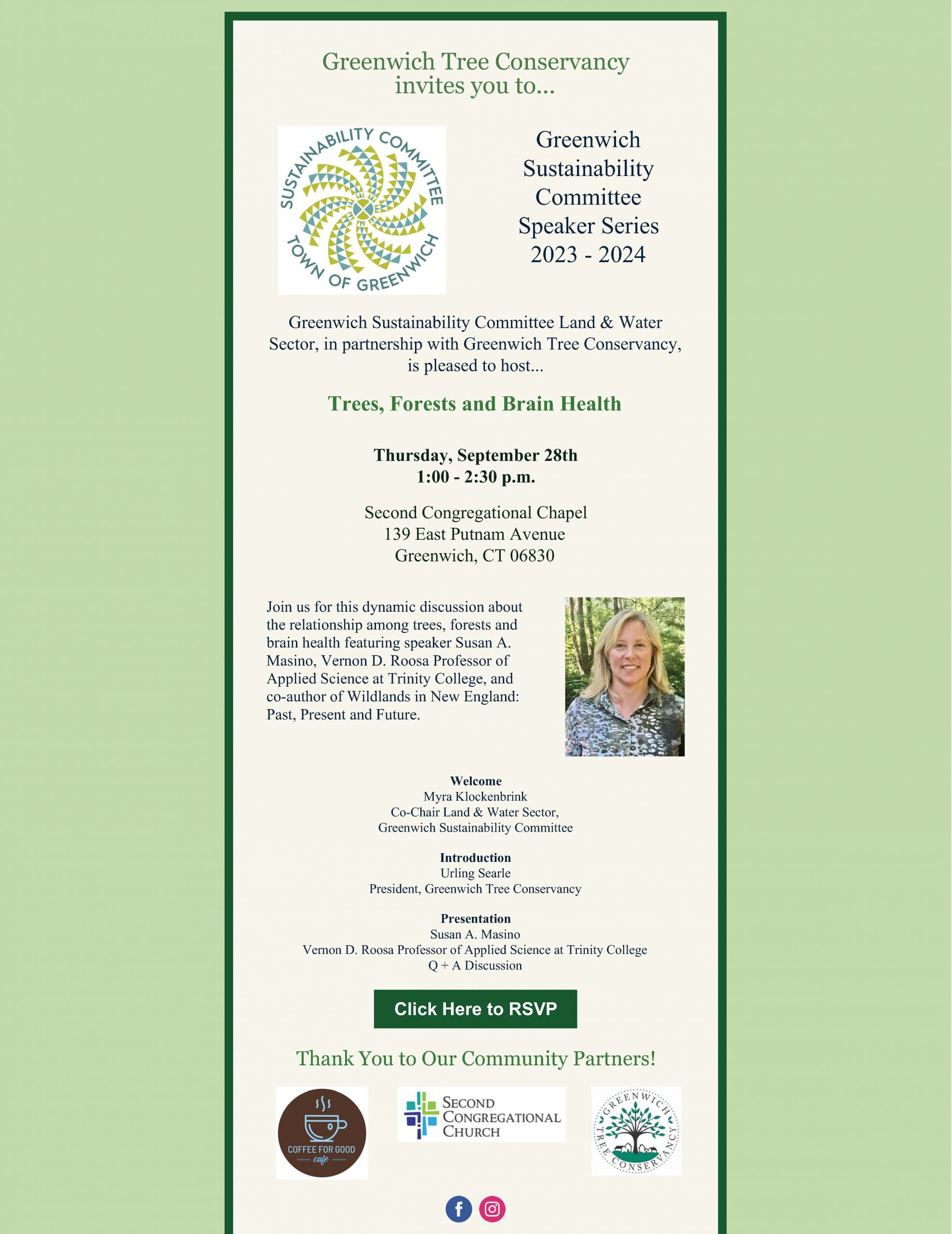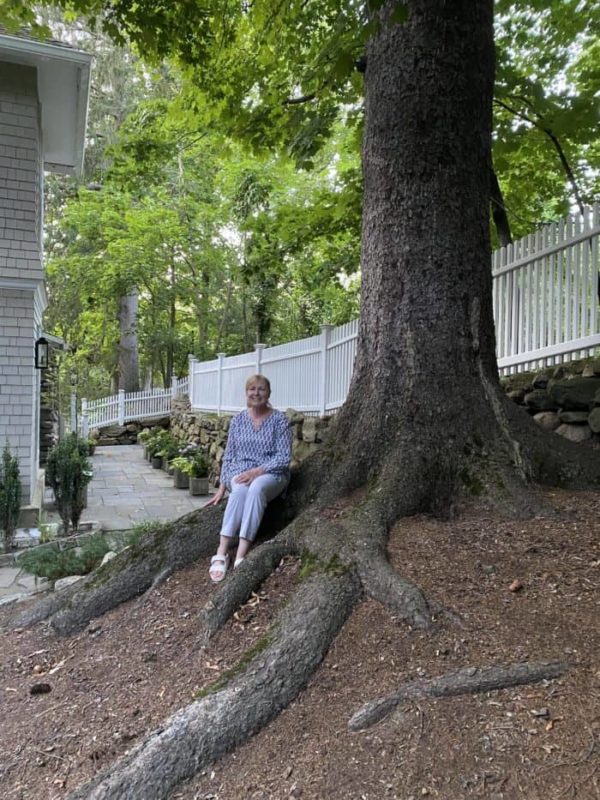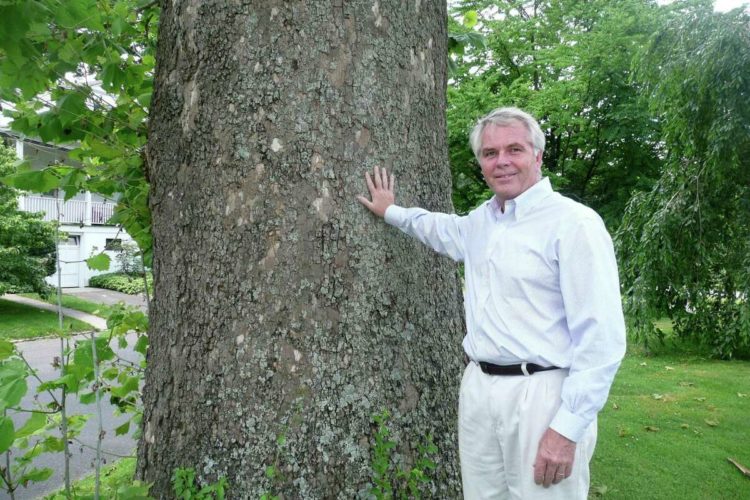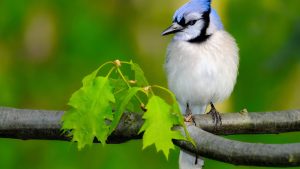Click here to view the online article in the Greenwich Sentinel.

Join the Sustainability Committee for informative and educational discussions on how the Greenwich Sustainability Sectors are responding to the challenges of the climate crisis.
The Speaker Series takes place at the Second Congregational Chapel from 1:00 – 2:30pm
Please visit our webpage: greenwichct.gov to sign up for our newsletter and follow us @greenwichsustainability to receive updates.
LAND AND WATER: September 28, 2023
Forests, Trees and Brain Health
Community Partner: Greenwich Tree Conservancy
WASTE REDUCTION: October 24, 2023
Waste Injustice: Impacts and Solutions
Community Partner: Waste Free Greenwich
COMMUNITY CULTURE: November 28, 2023
Building Ecological Climate Resilience Through Native Plant Landscaping
Community Partner: Greenwich Land Trust
FOOD SYSTEMS: January 30, 2024
Regionalizing the Food System in Response to Climate Change
Community Partners: Greenwich Community Gardens and The Foodshed Network
LEGISLATION AND ADVOCACY: February, 2024
BUSINESS: March 26, 2024
The Business Case for Sustainability: Why is it Important for Business to Adopt Sustainable Practices?
CLIMATE RESILIENCY: April, 2024
Climate Change Impacts in Greenwich: What Do We Need to Prepare For and How?
TRANSPORTATION AND AIR QUALITY: May 28, 2024
Spare the Air: Smog Season Starts with a Call to Drive Less and Landscape Responsibly
Contact Kim Gregory @ staglanefarm@yahoo.com with any questions.
Greenwich Sustainability Committee Speaker Series is in partnership with Coffee for Good and Second Congregational Church.
Original Source: Greenwich Sustainability Committee Speaker Series: Save the Dates | Greenwich Free Press
More info on this month’s event. To RSVP, email Kim Gregory at staglanefarm@yahoo.com.

In five years, Connecticut Department of Transportation’s budget for tree maintenance has nearly tripled in an effort to tackle what the department calls a “critical need” to address dangerous trees along the state’s roadways after years of drought and damage by invasives like emerald ash borer and gypsy moth.
But those efforts have raised the concerns of nonprofits dedicated to protecting some of the state’s trees and parkways who say that the department’s maintenance decisions can be haphazard and needlessly loss of mature trees.
CTDOT currently employs two Connecticut-licensed arborists within the Bureau of Highway Operations, and a department spokesperson told CT Examiner that four others on staff are in the process of obtaining a state arborist license. About 60 workers are assigned to tree maintenance.
Wes Haynes, executive director of the Merritt Park Conservancy, a nonprofit dedicated to revitalizing and celebrating the National Register and National Scenic Byway told CT Examiner that his group’s relationship with the construction side of the Department of Transportation is cordial and productive, but the maintenance side is another story.
“We don’t work very well with [maintenance] on that,” Haynes said. “Sometimes, they will get their wrist slapped by us and they don’t misbehave for a while and then, all of a sudden, they are back to taking [mature] trees down.”
Haynes said he believes the disconnect between the construction side and the maintenance side might be due to where the money comes from.
“The key is that there is federal money in the construction projects that triggers our participation.” Haynes said. “There is usually not federal money in the maintenance of the parkway and, therefore, maintenance feels they are independent of being good stewards of the parkway.”
Haynes suggested that a lack of funding might encourage a broader-brush approach to highway maintenance.
“They take down trees that they feel have to be taken down, but we do not always agree with them,” Haynes to CT Examiner. “They take them down, I believe, because they are wildly underbudgeted and, so, they get one shot at it. And, they say, ‘Well even if the tree isn’t a problem now it’s going to be a problem in five years, but let’s take it down prematurely now. So, there is no real planning that goes into the maintenance sector. They are pretty independent of the rest of the agency.”
But in emailed answers to questions sent by CT Examiner, the department suggested that what may seem like needless cutting to the untrained eye is necessary for the safety of vehicles on the state’s roadways.
“Dead, diseased and decaying trees must be removed. Trees that have grown into the ‘clear zone,’ which is the safe space along the side of the roadway, are also removed,” department officials explained. “This is to save lives in the event of a crash or vehicle leaving the roadway. A car crashing into a tree is like hitting a brick wall. Seventy-two people died between 2020-2022 due to crashing into a tree or having a tree fall on their vehicle…. Healthy trees are not removed unless they impact the clear zone and roadway safety.”
According to CTDOT, the department’s budget for tree maintenance has increased from $4.9 million in 2018, to $13.5 million last fiscal year and the department has had no difficulties hiring workers or employing sufficient numbers of trained staff.
The department told CT Examiner that its crews and outside contractors supervise, inspect and ensure safety while tree removal projects occur, and a Connecticut-licensed arborist and environmental planner review maintenance projects that involve tree cutting. A licensed arborist is not required to be on-site following initial evaluation, however.
Still, Haynes and others say there is a disconnect and that there needs to be more communication between CTDOT and conservancy and other groups.
Haynes noted that the maintenance division will often attend meetings of the Merritt Parkway Advisory Commission and “sometimes they will mention they are doing tree work and sometimes they do not. It’s completely random.”
JoAnn Messina, who has served as executive director of the Greenwich Tree Conservancy for the last 16 years, told CT Examiner that she’s often found that the maintenance division was uncommunicative as far as the number of trees that are taken down.
Messina estimated that “hundreds” of trees along the highway of I-95, the Merritt Parkway and Route 1 in Greenwich have been removed in the past year.
“They are supposed to talk to the town and the tree warden; but they often talk in generalities,” Messina said. “We need more communication. They need to realize that there is a benefit to having trees for the environment.”
There are currently several tree removal projects that are either currently ongoing or that were recently completed on the Merritt, especially in the Greenwich area, and in western Connecticut on I-84; and along the Route 7 Interstate in Norwalk and New Canaan.
Haynes said he’s hoping the state’s vegetation guidelines can be updated and “that we can get a new state policy that will help us protect the trees that do not need to come down and also to replant the trees that have to come down with new trees.”
Haynes said: “I think these are all fixable problems. We just need a little more enlightenment within the DOT and a little more trust in that we are not just out there to save every tree that is a threat to traffic. We want to keep the character of the parkway and the character of the parkway includes mature trees and young trees.”
Steven Trinkaus, who has a degree in forest management and whose business, Southbury-based Trinkaus Engineering, conducts civil engineering work, told CT Examiner that CTDOT “seems to be doing randomized clearing” of trees, especially near the Newtown and Southbury area along I-84.
Trinkaus said trees, even along the highways, have benefits.
Trees up to 10 years old “sequester about 13 pounds of carbon per year,” said Trinkaus, while trees between 10 and 80 years old, which are what is normal in New England, sequester about 48 pounds of carbon a year.
“That is great for the environment,” he said. “Trees have many benefits in that they provide shade, trees intercept rainfall and they can take in carbon dioxide and give you oxygen back.”
This story originally appeared in the CT Examiner at: Connecticut Triples Budget for Tree Cutting Prompting Concerns – CT Examiner
An excerpt from the article regarding the Greenwich Planning & Zoning commission’s discussion of the Central Middle School pre-application on the removal of 1800 trees.
JoAnn Messina, chair of the Greenwich Tree Conservancy, said while she understood the importance of student safety, she was concerned about the tree count and the loss of mature tree canopy.
“We do not have a wonderful track record with the Board of Ed,” she said.
Like Mr. Popp, Messina urged that replacement trees be fully budgeted.
“Again, we have history with Greenwich High School, New Lebanon and Hamilton Avenue school that the trees were not planted as approved by a plan. It’s really important that we do that.”
Messina mentioned that if there weren’t enough locations for replacement trees at CMS, they could be planted on other school campuses, which has been done in the past.
Click here to read the full story on Greenwich Free Press.

An Excerpt from “Opinion: Time for the Forest Service to protect old trees” by Henry Foushee, first published at Our climate depends in part on protecting old-growth forests (ctpost.com).
Who would’ve thought that the U.S. Forest Service could fail to see the forest for the trees?
National forests contain over 90 percent of federal mature and old-growth forests. More than three-quarters of this area is open to logging. That is shortsighted. New growth takes decades to reach maturity, and potentially centuries to attain the structural and biological diversity of an old-growth forest. Such harvesting also jeopardizes the stability of endangered species populations and increases wildfire risk.
Climate change makes protecting these areas all the more important. Mature and old-growth forests remove enormous amounts of carbon dioxide from the air. When these forests are logged, much of this carbon returns to the atmosphere, and their carbon removal capacity is lost. Yet, even as the Forest Service seeks public comment to guide new regulations, it intends to open up hundreds of thousands of acres of mature and old-growth forest to logging. To do so would severely harm efforts to combat climate change. The Forest Service must ban logging in mature and old-growth forests.
For the last four years the Greenwich Tree Conservancy has been honoring our chosen treasured trees with a nameplate installed on your winning treasured tree (GTC) that will be added to the Greenwich Tree Conservancy’s roster of Treasured Trees winners, plus a celebratory night when the winning treasured tree will be celebrated with a framed photograph of that treasured tree!

And what have been some of those winning treasured trees over the years? The American Elm, a Copper Beech, a Horse Chestnut, a Red Tip Photinia, a Katsura, a Sugar Maple, a Colorado Spruce, a Northern Red Oak!
So, do you have a tree that you treasure? Perhaps you’ve just planted one to celebrate an extraordinary person or event, or the birth of a child? Is there one that has guested many a bird or a squirrel’s dray, or offers a favorite climb for your kids, or even is hosting a tree house?
Are you an environmentalist keen on bringing down the level of CO2 in our air? Perhaps you have one of those top carbon-storing trees on your property, a Yellow Poplar or a Silver Maple tree or an Oak tree?
Have you always loved a tree in your neighborhood? The Greenwich Tree Conservancy’s Treasured Trees Program highlights special trees on private properties to create respect for the many beautiful and unique trees to be found throughout our community.
You can love a tree for many reasons: its special history, a memory or story; its magnificent size; its age; its species; its unique shape; its Spring flowers or Fall foliage and more! But seize the moment for the GTC deadline for proposing that treasured tree is this Saturday, July 15 (though the last word is they are accepting entries into next week).
To propose your treasured tree, visit the GTC website at www.greenwichtreeconservancy.org to access your nomination form. Also available online is a list of frequently asked questions. Nominations will be judged by two distinguished arborists. If selected by GTC judges, your tree will have a 5” x 7” nameplate mounted on the trunk of the tree.
And “the winner is” will be celebrated before a crowd of tree lovers at the GTC reception at the Sam Bridge Nursery and Greenhouses to be held on October 26 with the winner receiving that framed photograph of your Treasured Tree of 2023!
This article was written by Anne Semmes and originally appeared at Last Chance to Celebrate Your Treasured Tree for 2023 | Greenwich Sentinel.

“If you were to take a bird’s-eye view of Greenwich and then look down on it, you would see that…It truly looks like a town in a forest, although the part of the forest I was managing was just publicly owned trees.”
According to Spaman, Greenwich contains about 1100 acres of parks, including open-space properties, formal parks, and pocket parks. In addition, there are 250 acres of school campuses and 75 acres of athletic turf and fields. Add to that “a forest of street trees that’s probably 650 acres on over 265 miles of town roads. So, that’s a considerable forest that people drive in every day.” That responsibility only adds up to about six percent of the total land area in town.
Spaman’s interests in arboriculture and forestry began early. As a young boy, “I was in Boy Scouts . . . and I was always just out in the woods and on my own. I didn’t know you could make a job out of it.” He graduated with a degree in forestry from Paul Smiths College in Paul Smiths, New York, in the Adirondacks, in 1974. “From there, I just basically got immersed in trees in general, arboriculture doing tree work, learning the climbing, doing all that.” In the early eighties, the field of community forestry started to emerge which “brings together the arboriculture business and the forestry business . . . mostly with regards to managing municipal or town-owned trees.” Spaman worked for over thirty towns in Connecticut before being hired in Greenwich in 2002.
Read the full post on the Greenwich Sentinel at OHP BLOG – Greenwich – “A Town in a Forest” – Greenwich Sentinel
By Mary Shaw Marks
Did you know that Governor Ned Lamont designated April 2023 as Connecticut Native Plant Month. Upon learning of the accelerating loss of native trees and plants from the Garden Club of America, Governor Lamont chose to act.

Why is this significant? It is quite natural to take trees for granted. After all, we were born into this green garden of Eden. Along the way we’ve upset the critical balance nature provides by replacing plants native to our region with large expanses of lawn and exotic imported trees. While these landscapes may look pretty, to a caterpillar that our birds feed upon they are about as nutritious as a parking lot.
The native trees in our yards play a critical role in providing food and habitat for our pollinating insects, birds, and bees. When there are no native trees to supply food, there are very few insects, and if there are no caterpillars, there are no birds. Our own human food system also depends on a healthy insect population for pollination.
Why is this? Most insects have co-evolved with native trees and plants over millions of years and rely on them to generate their food. Plants don’t want to be eaten so they have developed their own defenses, thus creating a balance where they are nibbled, not destroyed, and insects have their dinner. This explains why many caterpillars only eat certain plants, like milkweed, and why native trees may be very healthy despite having a few holes in their leaves. This co-evolution supports a complex web of life.
THE SINGLE MOST IMPORTANT THING YOU CAN DO FOR BIRDS IS TO PLANT AN OAK TREE!
Well known expert and author of The Nature of Oaks, Douglas Tallamy, explains that North America has over 90 native species of Oaks hosting more than 897 species of caterpillars. These caterpillars fuel the food web with more species dependent on oaks than on any other plant. He notes that you really can bring an enormous amount of life into your yard by planting them and how well suited they are to suburban landscapes as you can easily plant underneath them as they grow tall. It appears the White Oak tree is Connecticut’s state tree for good reason.
In the runner up categories, you have the beautiful Pussy Willow feeding 400+ species. Black Cherry and American Plum support 400+ with flowers full of life in spring when Weeping and Ornamental Cherry provide scant food. River Birch, White Birch and Shaggy Birch are stars at 400+ with the shaggy bark offering many great nesting and hang-out spots. Both native and imported Crabapples host 300+, one of few imported species to provide nutritious nectar. Red and Sugar Maple come in with 280+ and are a great alternative to Japanese and Norway Maples which support little life. White Pines host 200+ and are great in woodlands. Like Silver Maples, they drop limbs and not recommended in yards. Native Dogwood has splendid spring flowers and berries that ripen in the fall exactly when birds need to fatten up.
Smaller understory trees such as Serviceberry and Redbud have early spring flowers and berries and seeds birds love. Native evergreens such as Eastern Red Cedar, Eastern White Pine, and American Holly provide food and places to shelter year-round. Seek out native and not cultivated varieties for the biggest impact.
We are currently experiencing an insect apocalypse, a crashing of our life supporting population. While we may happily celebrate the relative lack of annoying mosquitoes and flies, this is an ecological disaster. Since 1970 we have lost one third of our bird population. One third. Most especially the “backyard birds” whose songs we associate with spring days and time spent outdoors. In most yards 92% of green space is lawn, 75% of the plants are alien, and 10% are invasive, all planted by homeowners like us.
HOW WE LANDSCAPE OUR YARDS REALLY DOES MATTER.
Suburbs represent an opportunity and gardening is taking on a critical role. It is now within the power of individual homeowners to make a difference with the selection of trees and plants they choose. Think of that busy mother chickadee whose baby requires 3,000 caterpillars before leaving the nest!
In choosing trees to plant this growing season consider one of these stars that will offer you many years of beauty, shade and clean air while hosting and feeding the birds that sing to you each morning. The Greenwich Tree Conservancy works to plant, preserve, and protect wisely for the future health of our magnificent local ecosystem. The lush green garden we all take for granted.
he Greenwich Tree Conservancy is a non-profit organization dedicated to preserving and enhancing the trees of Greenwich for the benefit of community health and quality of life.
Mary Shaw Marks is a member of the Greenwich Tree Conservancy Board of Directors
This story originally appeared at https://www.greenwichsentinel.com/2023/05/06/column-why-plant-native-trees/

By Anne W. Semmes
They came in droves, the tree lovers, over 250, to celebrate the accomplishments of the now 16-year-old Greenwich Tree Conservancy (GTC), surrounded by explosions of color from a host of flowers laid out now for a twelfth year at McArdle’s Greenhouse. Guests were served sumptuous hors d’oeuvres from Happiness Is placed on those tree slice trays, with cocktails offered courtesy of Val’s Putnam Wines & Liquors.
GTC Chairman Peter Malkin and wife Isabel were not present in such a thick gathering but were represented by son-in-law Senator Richard Blumenthal who arrived with his walker having suffered injuries when a “fellow parade goer” tripped and fell upon him.
“I have the honor of representing Greenwich and the rest of Connecticut in the United States,” said Blumenthal, adding, “But more importantly, I am Peter and Isabel’s son-in-law. And so, I have to really mind what I say tonight! I’m so proud to be a Greenwich resident, to call Greenwich home. To have raised four children here with the kind of civic engagement and activism that the Greenwich Tree Conservancy demonstrates. So, please join me in a big round of applause for Urling Searle [GTC President], and JoAnn Messina [GTC Executive Director]. Thank you, JoAnn for your incredible leadership over so many years.”
Messina has presided over the planting of some 5,000 trees in Greenwich, along with the labelling of a thousand trees in the Town’s Arboretum. Add two more as Tree Party co-chairs, Shari Aser and Ellie Jenkins were recognized for their efforts by Searle with two trees to be planted in their names with their choice of where those trees are to be planted in town.

Aser stole a moment in her thanks to share the impact the Tree Conservancy has had on her life. “Exactly 12 years ago tonight,” she told, “I met my husband in this room, at this event.” “Clearly,” she added with a smile, “I had to co-chair the event eventually and plant many more trees… And I’m very glad [husband] Bill James asked me out after the event!”
“What a great night,” declared First Selectman Fred Camillo to the crowd. “It’s a week that we celebrate Arbor Day, daffodils, and Greenwich Tree Conservancy. And it shows that Greenwich is really a green town, and we treasure things like our trees.”
Worth adding here what Blumenthal also shared: “You know there’s an old saying that the sign of generosity is to plant a tree whose shade you will never enjoy. Looking around at this crowd, I think all of you are going to be around for the trees that we are planting – this is a very young crowd.”
So, perhaps the Town’s Tree Warden Dr. Greg Kramer who was present and thanked by our First Selectman for his tree-planting efforts might be the one to consult on tree choices to plant and where to plant. When asked by this reporter what might be his choice of ten trees to plant in Town, he came up with a list of “Top Ten” choices with full descriptions. See his choices listed separately here in the Sentinel!
Read the full story at https://www.greenwichsentinel.com/2023/05/05/greenwich-tree-conservancy-tree-party-brings-a-young-crowd-of-tree-lovers-together/
The Greenwich Tree Conservancy was awarded a grant from the Connecticut Urban Forest Council’s Urban Forestry Climate Change Grants Program to plant trees in areas that lack sufficient tree canopy, which can result in higher temperatures due to the heat island effect. The grant was initially for 50 trees but the Conservancy was able to plant double that number. The Conservancy worked with the Superintendent of Parks & Trees and the Town Tree Warden to carefully site locations for the trees based on climate change adaptability, urban survivability, wildlife benefits, and aesthetic appeal. The project also enhanced roadside construction off Exit 2 of I-95.
This originally appeared in the Greenwich Sentinel at https://www.greenwichsentinel.com/2023/04/28/news-briefs-april-28/